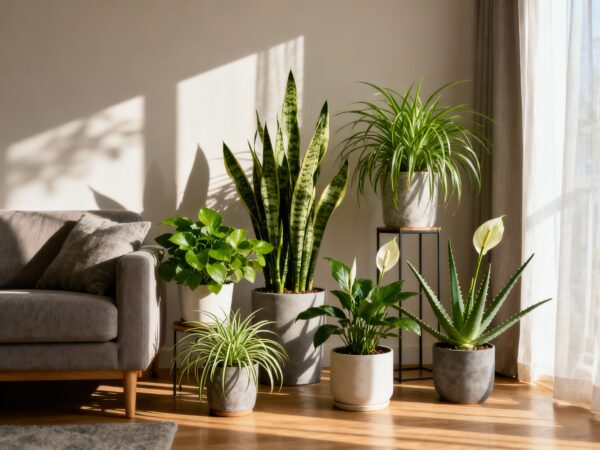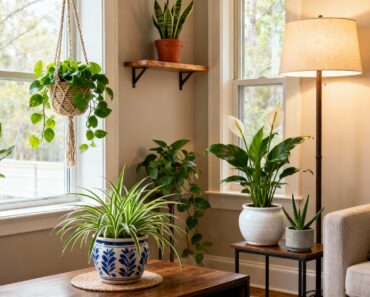In today’s fast-paced lifestyle, maintaining a vibrant indoor garden might seem like a daunting task, especially for busy homekeepers balancing numerous responsibilities. Fortunately, there are a variety of low-maintenance indoor plants that offer beauty, health benefits, and air purification without requiring constant attention. This guide introduces you to the best hardy plants that thrive with minimal care, helping you enjoy greenery in your home effortlessly.
Why Choose Low-Maintenance Plants?
Low-maintenance plants are ideal for homeowners with limited time or those new to gardening. They require less frequent watering, tolerate varied light conditions, and generally resist common pests and diseases. Beyond aesthetics, these resilient plants improve air quality, add a calming touch to interiors, and even boost mood and productivity.
Top Low-Maintenance Indoor Plants for Busy Homekeepers
1. Snake Plant (Sansevieria trifasciata)
Known as “mother-in-law’s tongue,” the snake plant is nearly indestructible. It grows well in low to bright indirect light and withstands infrequent watering—allowing soil to dry completely between watering sessions. The snake plant also purifies air by removing toxins like formaldehyde. Its upright, striking leaves add modern elegance to any room.
2. Pothos (Epipremnum aureum)
Pothos is a popular beginner-friendly plant famous for its trailing vines and adaptability. It thrives in low light but grows faster in moderate indirect sunlight. Pothos prefers moist soil but tolerates some neglect. It’s often grown in hanging baskets or pots on shelves and is appreciated for its rapid growth and easy propagation.
3. Spider Plant (Chlorophytum comosum)
Spider plants are resilient, tolerate a variety of light conditions, and reproduce by sending out small plantlets—perfect for gift-giving or expanding your indoor jungle. They require occasional watering when soil feels dry and effectively filter indoor air pollutants.
4. Aloe Vera
Aloe vera is a succulent celebrated for its medicinal gel but is also a straightforward indoor plant. It flourishes in bright, indirect sunlight and requires watering only when the soil dries out fully. Aloes improve air quality and their gel provides skin soothing benefits.
5. Peace Lily (Spathiphyllum spp.)
Peace lilies are favored for their ability to bloom indoors and adapt to low light. They prefer consistently moist soil but survive short dry spells. Apart from their aesthetic appeal, peace lilies detoxify indoor air and reduce mold spores. Note: they are toxic if ingested, so keep away from pets and children.
6. Rubber Tree (Ficus elastica)
This plant features large glossy leaves and thrives in bright, indirect light. Rubber trees tolerate irregular watering, preferring to dry at least 1-2 inches deep between watering. Their height and leaf size make them excellent for floor pots in living rooms or offices.
7. ZZ Plant (Zamioculcas zamiifolia)
ZZ plants amaze with their waxy, dark-green leaves and exceptional drought tolerance. They grow well in low to bright light, need watering only when soil is dry, and are resistant to pests. ZZ plants adapt well to varied indoor conditions, making them perfect for busy individuals.
8. Cacti and Succulents
These plants store water in thick leaves and stems, thriving in bright light with minimal watering. Their varieties range from prickly to smooth, small to large, and come in diverse shapes and colors. Overwatering is the primary cause of issues with succulents; allowing soil to dry thoroughly is key.
Care Tips for Low-Maintenance Indoor Plants
-
Watering: Most low-maintenance plants prefer letting soil dry out before the next watering to prevent root rot.
-
Light: Assess your home’s light conditions. While some plants tolerate low light (snake plant, ZZ plant), others prefer bright indirect light (aloe vera, rubber tree).
-
Soil and Drainage: Use well-draining potting mixes and pots with drainage holes to promote healthy root systems.
-
Fertilizing: Low-maintenance plants require minimal feeding; fertilizing once or twice per year during growing seasons is usually sufficient.
-
Cleaning: Occasionally wipe leaves to remove dust, helping plants photosynthesize more effectively and look their best.
-
Pest Monitoring: Watch for signs of pests or diseases; early detection keeps plants healthy with minimal intervention.
Benefits Beyond Convenience
These hardy plants are more than decorative; they help reduce indoor pollutants like benzene, formaldehyde, and carbon monoxide, improving air quality. Psychological studies highlight the mood-boosting and stress-reducing effects of indoor greenery. By adding low-maintenance plants, busy homekeepers create healthier, more relaxing environments effortlessly.
Final Thoughts
Incorporating low-maintenance indoor plants into your living spaces is a rewarding way to enjoy nature’s benefits without added stress. Whether you choose a sleek snake plant for a modern touch, a thriving pothos to cascade across shelves, or a serene peace lily for subtle blooms, these plants will enhance your home with minimal care. Start small, learn your plants’ needs, and soon you’ll cultivate a thriving green sanctuary perfectly matched to your busy lifestyle.
- https://www.provenwinners.com/leafjoy/easy-indoor-plants
- https://hesi.nl/blog/Houseplants-for-beginners
- https://homesteadbrooklyn.com/all/2017/1/21/growing-plants-indoors-a-beginners-guide
- https://www.southernliving.com/garden/indoors/best-indoor-plants
- https://www.joyusgarden.com/easy-to-grow-houseplants/
- https://www.fnp.com/blog/beginner-friendly-indoor-plants-a-guide-for-new-plant-parents
- https://www.pickuplimes.com/article/houseplant-care-tips-for-beginners-99
- https://www.facebook.com/groups/houseplantloversaddicts/posts/1795218574752966/



